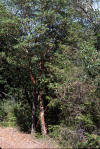|
Arbutus menziesii |
|
|
Carcache-Blanco E. J, M. Cuendet, E. J. Park, B. N. Su, J. F. Rivero-Cruz, N. R. Farnsworth, J. M. Pezzuto and A. Douglas Kinghorn. 2006. Potential cancer chemopreventive agents from Arbutus unedo. Nat. Prod. Res. 20(4):327-34. “A phytochemical study of the petroleum ether and ethyl acetate extracts of the entire plant of Arbutus unedo led to the isolation of a new sterol, 7beta-hydroxystigmast-4-en-3-one (1), and nine known compounds of the flavan, steroid, and terpenoid types. The structure of 1 was determined by spectroscopic data interpretation in combination with molecular modeling calculations. The absolute stereochemistry of C-7 was assigned as S for compound 1 based on the obtained CD spectral data. Activity in the JB6 cell transformation assay was found for pomolic acid 3-acetate (4). All isolates obtained were evaluated in a cyclooxygenase-2 (COX-2) inhibition assay.” Farr D. F., M. Elliott, A. Y. Rossman and R. L. Edmonds. 2005. Fusicoccum arbuti sp. nov. causing cankers on pacific madrone in western North America with notes on Fusicoccum dimidiatum, the correct name for Scytalidium dimidiatum and Nattrassia mangiferae. Mycologia 97(3):730–741. “Pacific madrone (Arbutus menziesii) is a broadleaf evergreen tree native to western North America that has been in decline for the past 30 years. A fungus has been isolated and was verified as the cause of cankers on dying trees. It was determined to belong in the genus Fusicoccum, an asexual state of Botryosphaeria. This genus in both its sexual and asexual states commonly causes canker diseases of deciduous woody plants. Using morphological and molecular data the fungus causing cankers on Pacific madrone is characterized, described and illustrated as a new species of Fusicoccum, F. arbuti D.F. Farr & M. Elliott sp. nov. No sexual state is known for F. arbuti. Evidence from the literature, cultures and specimens suggests that F. arbuti, often mistakenly identified as Nattrassia mangiferae, has been causing madrone canker since at least 1968. Authentic isolates of Nattrassia mangiferae as the synanamorph Scytalidium dimidiatum were sequenced and determined to be different from Fusicoccum arbuti and to belong in Botryosphaeria/Fusicoccum. In addition to molecular sequence data, the morphology of the pycnidial and arthric conidial states of Nattrassia mangiferae/ Scytalidium dimidiatum resembles that of Fusicoccum. Therefore the correct name for Nattrassia mangiferae and its numerous synonyms (Dothiorella mangiferae, Torula dimidata, Scytilidium dimidiatum, Fusicoccum eucalypti, Hendersonula toruloidea, H. cypria, Exosporina fawcetii, H. agathidia, and S. lignicola) is Fusicoccum dimidiatum (Penz.) D.F. Farr, comb. nov. Mekhfi H., M. ElHaouari, M. Bnouham, M. Aziz, A. Ziyyat and A. Legssyer. 2006. Effects of extracts and tannins from Arbutus unedo leaves on rat platelet aggregation. Phytother. Res. 20(2):135–139. “Many cardiovascular diseases such as arterial hypertension are associated with an increase in blood platelet activity. Arbutus unedo (Ericaceae) is a medicinal plant reputed to treat arterial hypertension, so the present study was undertaken in order to determine the antiaggregant effect. The crude aqueous extract showed an inhibition of thrombin-induced platelet aggregation (IC50 = 1.8 +/- 0.09 g/L, n = 10). The subsequent extraction of Arbutus unedo leaves by successive solvents showed that the methanol and ethyl acetate extracts accounted for most of the antiaggregant activity (IC50 = 0.7 +/- 0.08, n = 9; 0.6 +/- 0.05; n = 9, respectively).The tannins isolated from the methanol extract exhibited a strong antiplatelet effect (% of inhibition = 75.3 +/- 1.4, n = 8) and may be the major chemical compounds responsible for this action. Our results support the traditional use of this plant in the preventive or therapeutic treatment of platelet aggregation linked to arterial hypertension.” |
|

